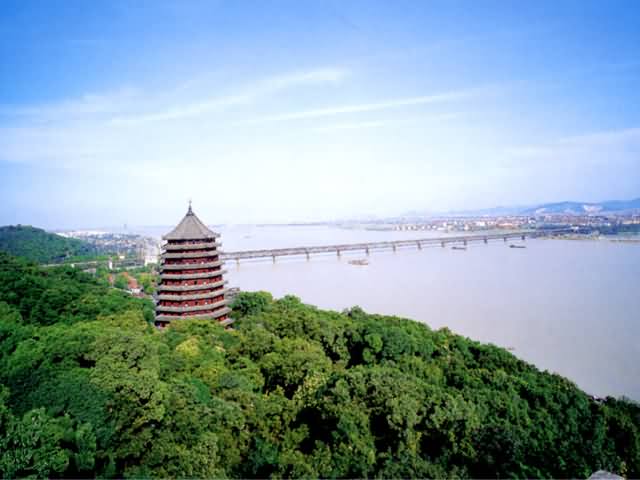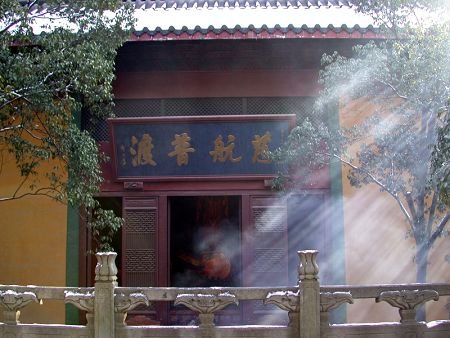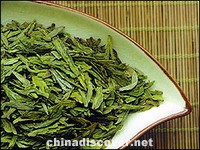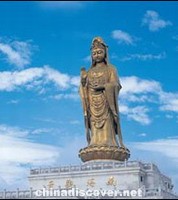History of Hangzhou
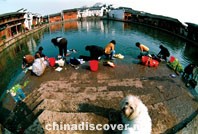
Fast-Fading Shadow Magic
Another of Haining's attractions is the opportunity it offers to enjoy the ancient performance art of Shadow Play -- regarded as a live fossil of drama. There are many stories as to its origins, the most popular dating back to Han Emperor Wudi (156-87 B.C.) and the death of Li, his favorite concubine. Li was admired for her dancing and singing accomplishments as well as her stunning beauty. Her death at a tragically young age broke the emperor's heart. A wily spiritualist offered to conjure up her spirit, which took the form of a young woman's silhouette visible against a voile curtain by candlelight. The Emperor was apparently comforted by it.
Shadow play is also known as leather-silhouette show. It is a traditional folk art. The making of the stage props of shadow play is the following: handicraftsmen cut processed goat hide or ox hide in to human or animal models like paper-cut, then the performers use pointed bamboo slips to stick the models on the back of the white cloth screen (with light cast upon) and play the stories.
Originated in the Spring and Autumn Period (BC 770-476), the shadow play was introduced to the royal palace in the Western Han Dynasty (BC206-AD23). In the Tang Dynasty (618-967), the workmanship of the shadow play prop became more exquisite and delicate. By the Song Dynasty (960-1279), it became a formal opera and was listed in the so-called "hundred operas". That period witnessed the great prosperity of shadow play, and many Song books mentioned about this folk art. The rise of Zhejiang's shadow play was connected with the removal of the Song Court to Zhejiang's Hangzhou City in the year 1127. During that time, a lot of artists and craftsmen moved from the North to the South with the royal court. With the combination of the North techniques with the South culture, the shadow play was very popular in Zhejiang.
The themes of Chinese shadow play are mostly historical stories and legendary, such as "the Monkey King fighting against the Ox King","Outlaws of the Marsh","A Tale of General Yue Fei","Female Warrior Fan Lihua" and "Apotheosis of Heroes".In the old times, in the festivals and occasions of celebrations, shadow play always played an important role and it was one of the major entertainment forms. Today, people can hardly have a chance to appreciate this ancient folk art. But Wuzhen Town still remains the performance of shadow play.
This venerable performance art first emerged in northern China, but was swept south along with the exodus of theatrical performers escaping the ravages of wartime. Its absorption of southern cultural elements helped it evolve into a unique genre. Haining was the hub of Shadow Play in southern China, and is still a major venue for the ancient art. Production and performance techniques have been handed down from generation to generation, any innovation having being viewed with extreme reservation. Contemporary Haining Shadow Play is hence little different from what it was in the Song Dynasty, as compared to that performed in other regions which adapted and changed with the times.
Haining Shadow Play puppets are more flexible than those of other regions because their joints are linked with quills rather than thread or metal hooks. The Song legacy is most evident in the formal quality of the Haining Shadow Play style of performance and music, whereby the stage is fringed with lanterns and flanked with lion statues on either side. The accompanying songs are the Southern Haiyan and Geyang tunes that were popular during the Southern Song Dynasty.
By the end of the Qing Dynasty, Haining Shadow Play had made its name in Zhejiang Province and Shanghai. At one time there were as many as 600 Shadow Play performers in about 60 troupes, the most distinguished of whom were invited to perform for the emperor.
But Shadow Play, in common with many other facets of Chinese culture, was almost completely destroyed during the cultural revolution. It was at the 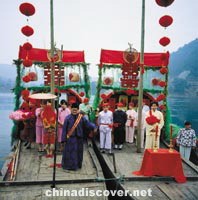 beginning of the 1990s that Shadow Play puppeteer Wang Qiansong summoned the seven surviving Shadow Play craftsmen to help him rebuild the famous Lang Family Troupe.
beginning of the 1990s that Shadow Play puppeteer Wang Qiansong summoned the seven surviving Shadow Play craftsmen to help him rebuild the famous Lang Family Troupe.
Founded in 1875 by Lang Achun, during its prime the Lang Family Troupe had several companies, and lanterns bearing the Lang name lit the Shadow Play stage in towns and cities throughout southern China. The last family head of the troupe was fourth-generation puppeteer Lang Zili, who learned the art from his father and grandfather as a child and started performing at the age of 13. Four years later, his grandfather's deemed him qualified to act as troupe head, and Lang Zili lead the troupe to glory when, in the 1950s, he and his company performed for state leaders, including vice premier Chen Yi, in Beijing.
Wang Qiansong was originally an exponent of the folk art of paper cuts. During the cultural revolution he risked his life by concealing Shadow Play props within the wall of his sheepfold, thus saving them from willful destruction. When the national chaos died down, he repaired the puppets and resuscitated this most celebrated of Shadow Play companies. Wang has so far created more than 1,000 leather puppets and restored 300 of the traditional plays in the Lang Family Troupe. It has since toured several metropolises within China and also traveled abroad.
The troupe's prospects are nevertheless grim. Some of the eight folk artists who helped revive it have died, and those still living are in their 80s. The death of one, Lang Zili in a car accident in 2002, struck a heavy blow, as none of his children were versed in the craft. This put paid to the familial aspect of the troupe. In order to save Haining Shadow Play from total extinction, Wang Qiansong went on a tour of schools throughout the nation, giving lectures on this precious facet of Chinese performance culture and encouraging schools to run specialized courses on it.
